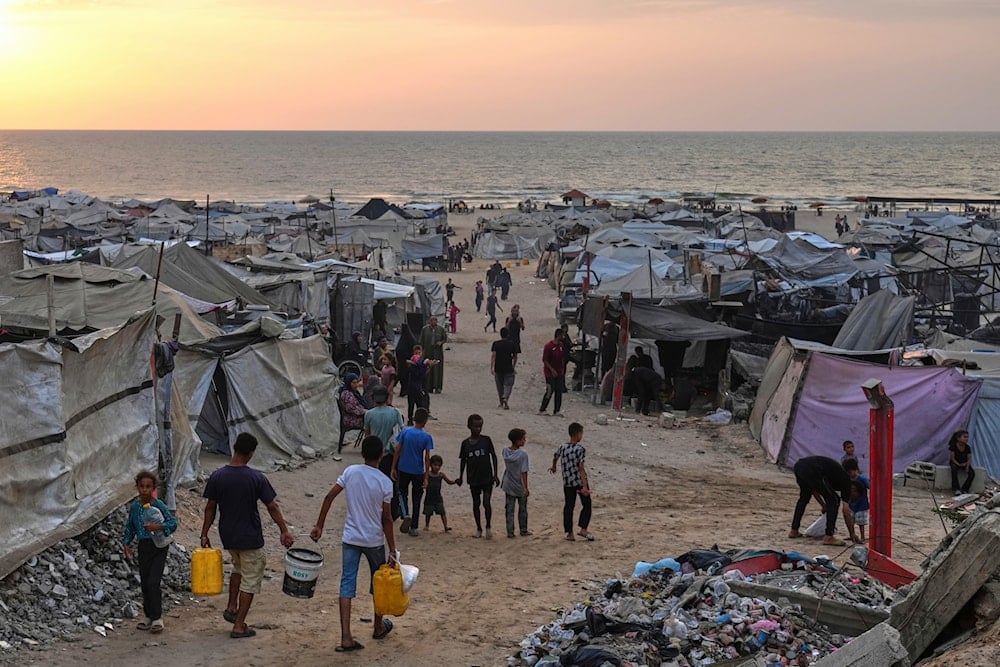Hamas, other factions accept Egypt-Qatar ceasefire proposal: Exclusive
The approved ceasefire proposal involves prisoner exchange, humanitarian aid, and the reopening of the Rafah crossing.
-

Displaced Palestinians walk through a makeshift camp along the beach in Gaza City, Sunday, Aug. 10, 2025 (AP)
Hamas and other Palestinian Resistance factions have accepted a ceasefire proposal brokered by Egyptian and Qatari mediators, a senior Palestinian official told Al Mayadeen.
Later, Hamas confirmed in a statement that it accepted the ceasefire proposal in the Gaza Strip, handed over yesterday by Egypt and Qatar.
"The Hamas movement and the Palestinian factions informed the mediators of their agreement to accept the proposal handed over yesterday by Egypt and Qatar," the statement read.
Proposal detailed
The high-ranking official informed Al Mayadeen that under the proposal, Israeli forces would withdraw one kilometer from areas in northern and eastern Gaza, though the towns of al-Shujaiyya and Beit Lahia in the north would remain excluded from this withdrawal.
The source further explained that the deal would secure the release of 10 living Israeli captives in return for freeing 140 Palestinian prisoners serving life terms and 60 with sentences exceeding 15 years. It would also see the release of 1,500 Palestinians detained from Gaza.
Moreover, the deal stipulates that for every Israeli captive's remains returned, the bodies of 10 Palestinians will be released, while also mandating the unconditional release of all incarcerated women and children.
Extensive aid to flow into Gaza once the agreement takes effect
Moreover, the official additionally pointed out that the proposal stipulates modifying redeployment maps in the northern and eastern areas, adding that aid will be sent to the Gaza Strip immediately upon the agreement taking effect, in intensive and coordinated quantities, as per the January 19, 2025 agreement.
The source told Al Mayadeen that the humanitarian assistance would include fuel, water, and electricity supplies, along with the rehabilitation of hospitals and bakeries, plus heavy equipment for debris clearance.
In detail, the UN and its affiliated agencies, as well as the Red Crescent and international organizations operating in Gaza, would be responsible for receiving and distributing aid.
The senior official added that under the proposal, the Rafah border crossing in southern Gaza would reopen for two-way traffic, consistent with prior agreements.
Egyptian official confirms Hamas acceptance
An Egyptian official source confirmed that Hamas has accepted the ceasefire proposal put forward by Qatar and Egypt, adding that the proposal will include a path toward a comprehensive deal to end the war on Gaza, Reuters reported on Monday.
Moreover, Israeli Prime Minister Benjamin Netanyahu's advisor, Dmitri Gendelman, said "Israel" received from mediators the Palestinian movement Hamas' response to the proposal for a ceasefire in the Gaza Strip and the release of captives.
Reuters cited the Egyptian official as saying that the deal includes a temporary suspension of all military activity for 60 days, with this period seeing the exchange of Palestinian prisoners and detainees in return for the release of half of the Israeli captives held in Gaza.
Israeli media reveal terms of new US Gaza ceasefire proposal
This closely follows reports by Israeli media revealing the terms of a ceasefire proposal put forward by the United States, which includes a multi-phase withdrawal that begins with a temporary ceasefire accompanied by negotiations that would determine the final stage of the war.
As reported by Israel Hayom, the initial phase of the agreement would involve a 60-day truce combined with a prisoner swap, where Hamas would free 10 living Israeli captives and return the remains of 18 others, while "Israel" would release more than 1,200 Palestinian prisoners and detainees, some serving life sentences, along with detainees held in its jails.
The proposed framework outlines a second phase focused on securing a full and lasting ceasefire, followed by a final stage that would transition Gaza to an internationally supported governance structure, led by the US and prioritizing large-scale reconstruction, as part of the long-term stabilization plan.

 4 Min Read
4 Min Read








